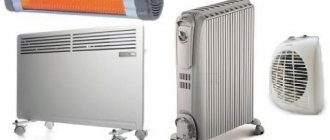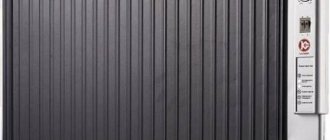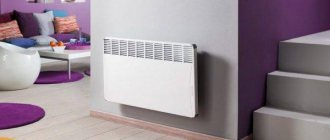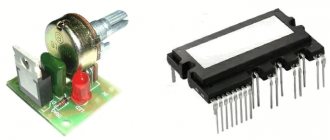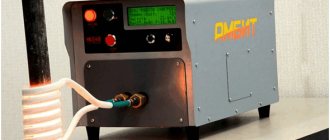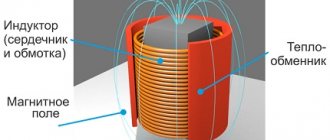Principle of operation
An oil heater consists of a metal body that visually resembles a stationary battery, special mineral oil and a heating element.
After turning on the device, the heating element begins to work, heating the oil to the desired temperature. Next, the oil transfers its heat to the metal shell, which gradually heats the surrounding air.
All modern models have several operating modes, thanks to which you can choose the intensity of heating the air in the room.
The built-in timer helps regulate the temperature: when the air is heated at a given temperature, the device turns off, and when it gets cold, it turns on.
What is an oil cooler and how does it work?
Externally, an oil radiator looks like a sectional radiator on wheels. Its body consists of several metal sections. It is filled with special mineral oil and equipped with an electric heating element. When you plug in the device, the heating element begins to heat the oil inside the radiator to the desired temperature. The sections heat up from the oil. And their heated surface warms up the air in the room. Warm air, according to the law of physics, rises and gradually fills all the air space in the room. The room becomes warm and comfortable, just as you wanted.
For safety and rational energy consumption, all oil heaters are equipped with built-in thermostats. The thermostat controls the heating temperature of the oil and turns off the device when it reaches the desired value. When the oil temperature drops, the heater turns on automatically. This principle of operation eliminates overheating of the device, keeps the temperature in the room at a comfortable level and allows you to save energy.
Types and characteristics of oil heaters
All radiators operate according to the same algorithm, but differ in the set of additional functions, type of mounting and price. Depending on the goals set for the device and its location, oil radiators are divided into:
- Wall-mounted – economical in terms of electricity consumption.
- Floor-standing ones are popular because of their mobility.
- Tabletop - low level of heat transfer.
- For cots.
- Ceiling.
Some models are equipped with a fan that disperses flows of warm heated air throughout the room. The disadvantage of such a device is noise during operation. The developers of some companies have included a humidifier in their models.
This device is especially relevant in the cold season, when the air outside becomes much drier, and the heater itself gradually dries it out further. Some units have a delayed start function.
Advantages of oil heaters
- High level of device security. In an oil radiator, all heating elements are hidden inside, and the outer shell heats up to a temperature of no more than 60 degrees.
This eliminates the possibility of a fire due to a fall or burns to the skin surface due to tactile contact. The last factor is important in families with small children.
- Long service life. The device is designed in such a way that the components do not burn out due to long continuous operation. The device can work without turning off for up to three days.
- The compact size of the device and its mobility allow you to move it to different parts of the house or apartment. And quiet operation will not cause any discomfort.
- The price of oil radiators is affordable. The cost depends on the number of sections that the device has.
- No foreign odors are emitted during operation of the device. Radiators do not dry out the air in the room, which means that you do not have to spend extra money on purchasing a humidifier.
- To install such a heater, you do not need special knowledge or tools. You simply plug in the device and enjoy the warmth.
Comparison of device parameters
To determine whether an oil or convection heater is better, you need to compare the technical parameters and other properties of the devices. This will allow you to make a choice in favor of one of the devices and not make a mistake when purchasing.
Warm-up time and energy consumption
An oil radiator requires additional time to heat the room, because its heating element first heats the oil, which then gives off its heat to the body, and only then does direct heating of the air begin. As for the convector, immediately after being connected to the network it begins to fulfill its purpose. Because of this, the oil heater spends more energy, and the convector is more economical.
But if you purchase a radiator model equipped with a fan, the air heating time will be significantly reduced. In addition, after being disconnected from the network, the oil device cools down much longer, and accordingly, the temperature in the room also does not drop so quickly.
Safety at work
For a device with hot oil inside, the body heats up to a temperature of 90°C, and sometimes higher. If used carelessly, this may cause burns. Families with small children need to be especially careful. They may be advised to opt for a heater with a protective casing.
But it is not recommended to leave a radiator protected by a casing unattended , since if it accidentally falls, there is a high probability of overheating of the heating element, and as a result, a fire hazard. We must also not forget that it is prohibited to use the device for this purpose without a special device for drying clothes, because if air access to the device is blocked, it can cause a fire.
The difference between a convector and an oil heater is that it is 100% safe. Under no circumstances will the temperature of its case rise above 60°C, and in case of a fall, each such device is equipped with a special sensor that disconnects it from the network. The convector is allowed to be used even in bathrooms, which cannot be said about its “rival”.
Ease of use
The weight of the oil cooler is quite impressive: from 15 to 25 kg. Despite the existing wheels, moving the device requires some effort. The convector weighs only about 10 kg, and is usually hung on the wall, where it does not cause any inconvenience. Some device models are also equipped with wheels, making them much easier to move.
also heats the air much more evenly , creating a more comfortable environment. The same cannot be said about oil-based devices. After all, the air temperature next to them is usually much higher.
Thanks to its appearance, the convector will fit perfectly into any environment and will not introduce dissonance into the surrounding atmosphere. But the oil one is unlikely to be positioned so that it does not attract unnecessary attention.
Care and service life
In terms of caring for appliances, an oil heater is much easier. Its body needs to be wiped from dust from time to time, which does not take much effort and time. With a convector, you should constantly monitor the condition of the holes through which air circulates. If they become dirty, problems with the operation of the device may occur.
As for the service life of the device, the convector differs from the oil radiator in having a longer service life. Sooner or later, microcracks appear in the body of an oil-powered device through which the contents leak out. This kind of damage can no longer be repaired.
Environmental friendliness and price
Both types of devices are environmentally friendly . They do not burn oxygen, do not dry out the air and do not emit harmful substances. You can safely use them without fear of harming your health. But the cost of the convector is much higher, which can be explained by its higher quality. However, the low price of an oil cooler makes it more affordable and popular.
Thus, we can conclude that the convector is superior to an oil heater in many respects, but the final choice remains with the individual consumer. But despite the difference in some parameters, both devices cope with the task of heating the room.
Disadvantages of oil heaters
An oil cooler has several negative aspects that you need to be aware of before purchasing. They are quite controversial and can be easily eliminated:
- Heavy radiator weight. It will not cause any difficulties when moving, since each model is equipped with wheels, and there is no need to lift the unit at all.
- Long room heating time. First, the heating element inside the device heats the oil, and only after that does it heat the outer shell of the radiator.
But this drawback can be easily eliminated if you initially purchase a radiator with a built-in fan, which will disperse warm air around the room, thus heating it up faster.
How to choose an oil heater
Consider simple rules:
- Heater power. To heat 10 square meters of area you need about 1 kW of power. The manufacturer does not produce radiators with a power exceeding 3 kW. To heat larger rooms, you will need several copies.
- Size. The number of sections ranges from 5 to 14. The more sections in the radiator, the faster it will heat the room and the more electricity it will consume.
- Model design . When purchasing, pay attention to the presence of a light indicator, temperature controller and several operating modes. There should also be protection against overheating of the device, which will protect you from unforeseen situations.
With several modes, you can independently regulate the temperature that the device produces, and thus save the energy it consumes.
- Timer , with which you program the radiator to turn on or off for a certain time.
- Built-in air humidifier . During the cold season, the air becomes dry, which negatively affects the skin. The built-in air humidifier operates while the heater itself is operating, bringing the humidity in the room back to normal.
- Built-in fan. It will speed up the process of heating the room, but models with this function are much more expensive.
Also pay attention to the following aspects:
- Give preference to radiators with narrow sections. They heat up faster and transfer heat to the room. When reducing the size of sections, increase their number.
- Large sections take a long time to heat up and cool down, this provides additional heat, but requires additional electricity costs.
- If the device is lightweight, but at the same time large in size, it means that the manufacturer has saved on materials.
- Radiators of dark color give off heat better.
Where can an oil heater be used?
Most often, oil radiators are used as an additional and backup heating device. It will come to the rescue during the off-season - autumn and spring, when the central heating has not yet been turned on or has already been turned off. In case of emergencies related to the operation of the heating system, the radiator will save you again. If it is not warm enough for you in your own apartment, even with heating, you can buy an oil heater and turn it on when necessary.
An oil radiator can also be used for main heating. But only in small areas - in rooms, on glazed loggias and verandas, in small country houses, in closed trade kiosks.
Which is better
Before purchasing a radiator, you should calculate how much area it will need to heat. The heating function depends on the power of the radiator and the number of sections.
The power is selected depending on the size of the room in which the radiator will operate: for 10 square meters of room you need 1 kW of generated electricity.
The formula applies to rooms where the ceiling height is no more than 2.75 m. If the ceilings are located higher, the required power can be calculated using the following algorithm:
- Multiply the length of the room by the width to get the area.
- Multiply the resulting number by the height of the room, this way you will get the required volume.
- Divide the resulting figure by 25, because 1 kW of energy per 25 m3 is calculated. The result obtained is the power needed to heat the room.
Then it’s a matter of individual taste and financial capabilities. A simple oil heater has a standard set of functions and is inexpensive.
Models equipped with fans, timers, humidifiers and remote controls are more expensive, but more comfortable to use.
Oil heater service life
Household oil heaters for the home - selection, purchase, operation
Answer
Posts: 27 • Page 1 of 3 • 1 , ,
Oil heater service life
Question » March 25, 2013, 09:02 pm
An important indicator when choosing an oil heater for home use is the service life.
Of course, every self-respecting manufacturer indicates it in the passport. But does the actual service life coincide with the one indicated in the passport? Is there any experience of really long-lasting oil heaters? Question Messages: 29 Registered: Mar 25, 2013, 8:19 pm
Return to top
Oil heater service life
Sergey N » March 26, 2013, 16:53
It’s hard to say for sure. It depends on the assembly and the quality of the parts, but more on the assembly. There is a good expression: If the Chinese one doesn’t break right away, it will work forever. This statement applies to a large extent to equipment such as an oil heater. Weak points are the wire connections, as well as the toggle switches, if you turn them often.
The most economical gas heaters + reviews - https://www.optcentre.ru/topic/3185-otzy ... #entry4007
Sergey N
Messages: 2684 Registered: March 11, 2012, 23:18 From: Kazan
Return to top
Oil heater service life
Anatoly » April 09, 2013, 03:06
Currently, the range of oil heaters is very large.
Different in design, different in power, but usually with power regulators. The heating elements are closed and are in oil. The flash point of the oil is about 180 C. Therefore, the service life can be divided into two stages. The first is the reliability of the Tens. It directly depends on the material of the spiral, the grain size of the sand being poured, the tightness of the electrical insulators and some other characteristics in general that we do not know. As a rule, high-resistance spirals work reliably, and the threaded connection of the contacts often fails due to overheating. But after stripping and fastening the wires well, there should be no sparking and the oil heater works without problems. The second stage is associated with the operation of the oil. The heater can not only fail, but also be the source of a fire, and without fault. If locally overheated, the oil heater may explode. This is not a horror story, but our human reality, when instead of common sense there are experiments at random!!! It should not be covered with any kind of capes, it should not be laid on its side, or turned over. All this contradicts the operating instructions and is due to the fact that the oil easily overheats. Do not dry your socks on the heater. Therefore, to increase the service life of the oil heater, it is advisable to strictly follow the operating instructions and not get carried away with working at maximum load. The lower the load, the lower the heating temperature of the heat exchange surface. I consider the normal temperature on the working surface to be in the range of 50 ... 60 C. The palm cannot withstand such a temperature. I use an old flat Soviet 500 W oil heater. The only regulating device is a bimetallic thermostat, exactly the same as in irons. He has been working for me for about 25 years. The rubber-braided cord was never replaced, and the contacts on Tene burned out. With regard to modern heaters, it is worth noting that oil leaks and overheating are unacceptable. The normal service life of an oil heater is about 7 years. If you want to live in peace, buy a new one. If you want to play with fate, like me, play. But I am not a role model, I will improve! Anatoly Messages: 1707 Registered: Apr 03, 2013, 01:23
Return to top
Oil heater service life
Sergey N » April 17, 2013, 15:49
Although Soviet technology was not so functional, it really does last for at least 30 years, that’s a fact! As for the service life of modern heaters, it works no more than 10 years. In general, some parts there can last 30. If you know a little about heaters and technology, you can easily extend its life. A common problem is thermostat failure and broken contacts due to oxidation or poor soldering. Heating elements and oil are practically eternal.
The most economical gas heaters + reviews - https://www.optcentre.ru/topic/3185-otzy ... #entry4007
Sergey N
Messages: 2684 Registered: March 11, 2012, 23:18 From: Kazan
Return to top
Oil heater service life
Rikota » April 18, 2013, 11:43
Well, Sergey, what does it mean - at least 30 years?
There were no such deadlines in any regulations! Another thing is that due to the lack of a sufficient number of consumer goods on the then Soviet market, people were driven out and tried to make “candy” out of an unsuitable substance. Remember, there was a soldering iron in almost every house; people were always fixing something. Telemaster was a profession in great demand, because televisions were constantly breaking down! It’s now the “washing machine” that’s leaking—to the trash heap! And before they repaired, soldered, tinned, and out of three they assembled one, because it was incredibly difficult to buy a new one due to the shortage! Rikota Posts: 994 Joined: Mar 11, 2013 12:41 pm
Return to top
Oil heater service life
Anatoly » April 19, 2013, 20:46
Sergey N wrote: If you know a little about heaters and technology, you can extend its life without any problems. A common problem is thermostat failure and broken contacts due to oxidation or poor soldering. Heating elements and oil are practically eternal.
If we are talking about the plug, power cord and contacts, then such faults can be eliminated. But the fact is that “Heating elements and oil are practically eternal.” difficult to agree. And how many of these heating elements fail??? Yes, oil can also be a problem. Over time, the oil cokes and it changes its characteristics... And why then do they give a guarantee for either 6 months or a year??? And this happens all the time... Anatoly Messages: 1707 Registered: April 3, 2013, 01:23
Return to top
Oil heater service life
Igor_01 » 14 May 2013, 13:41
Yes. The manufacturer can specifically make the oil or other things age over time and the buyer comes for a new product. This is marketing; fewer and fewer quality goods are being produced today. When I buy something at a low price, I already obviously invest in it the cost of “finishing” the product. But for example, transformer oil is very durable. Can I fill it?))
Climate equipment supply network - https://www.optcentre.ru/topic/1842-nuzh ... ht/?p=2605 - https://www.optcentre.ru/
Igor_01
Posts: 2010 Registered: Apr 13, 2012, 12:23 PM
Return to top
Oil heater service life
Igor_01 » February 18, 2014, 2:00 pm
That’s something else. For irons and other electric heating devices, the manufacturer generally gives a guarantee of no more than 1-3 months. I asked why so little? The manager says that they have weak contacts and nichrome inside. That is, such an iron can basically fail very quickly. This is not a Soviet reinforced concrete device! It’s definitely eternal, it will work for 100 years)
Climate equipment supply network - https://www.optcentre.ru/topic/1842-nuzh ... ht/?p=2605 - https://www.optcentre.ru/
Igor_01
Posts: 2010 Registered: Apr 13, 2012, 12:23 PM
Return to top
Oil heater service life
Anatoly » March 22, 2014, 1:34 pm
Igor_01 wrote: Yes, yes. The manufacturer can specifically make the oil or other things age over time and the buyer comes for a new product. This is marketing; fewer and fewer quality goods are being produced today. When I buy something at a low price, I already obviously invest in it the cost of “finishing” the product. But for example, transformer oil is very durable. Can I fill it?))
If you guarantee safe operation for yourself, then change the oil only at your own responsibility. Transformer oil has a flash point of 180 C. And the maximum temperature of the oil in the radiator should not be higher than 110 - 130 C. So there is a temperature margin here. By the way, I’m currently using old Soviet oil plate radiators with a power of 500 W... They outlived their warranty 20 times. They don’t leak and the heating elements haven’t burned out yet... Let them work... Anatoly Messages: 1707 Registered: Apr 03, 2013, 01:23
to come back to the beginning
Oil heater service life
Bibikin Ivan » March 28, 2014, 08:36
They outlived their warranty 20 times. They don’t leak and the heating elements haven’t burned out yet... Let them work... After 3 years of use, you can guarantee that the device will work for at least 10 years. Why are Soviet devices so durable? It’s stupid because they don’t have any electronics, the heating element is sealed from oxygen with oil, and there are no aging plastic parts. That's all science!
We are moving to live on a desert island! With us?! — https://www.neobitaemyi.ru/
Bibikin Ivan
Messages: 1662 Registered: May 16, 2012, 14:10 From: Moscow
Return to top
Answer
Posts: 27 • Page 1 of 3 • 1 , ,
Return to Oil heaters (radiators)
Who's at the conference now?
Registered Users: Bing [Bot]
Switch to mobile style
Exploitation
Precautionary measures:
- Before you start using the device, make sure that the voltage in the apartment outlet corresponds to that recommended by the manufacturers.
- If you are not using the device, unplug it from the outlet.
- Do not leave the device on when there is no one in the room.
- Do not cover the device with clothing, this will cause overheating or a fire. It is better to place it at a safe distance from flammable substances.
- Keep the device clean.
- In the event of a breakdown, do not try to disassemble the radiator parts yourself; it is better to leave this work to professionals.
- Supervise children closely if they are in the same room as the device is in use. Do not allow them to play with the cord or appliance, as this may result in short circuit, electric shock or fire.
- Carefully monitor the condition of the device itself, the wire and the plug. Do not use the heater if the cord or plug is damaged.
- The device is intended exclusively for indoor home use.
Preparing for work
If the device was purchased in the cold season, then it must be carefully unpacked, placed on wheels and left for at least 3 hours.
After this, plug the radiator into a grounded outlet and leave it to work for 1 hour in a ventilated area. This will evaporate all foreign odors that may appear at the initial stage.
Oil Cooler Maintenance
Oil heaters do not require special maintenance during their service life, unless there are any complaints or complaints.
- If you need to store the device for a long time, wipe it with a slightly damp cloth to remove dust and dirt, disconnect the cord, and roll it up carefully. Remove the support wheels and put them in a box, which you close tightly.
- When you need the heater again, take it out of the box, wipe it off again from dust, and reassemble it. Carefully inspect the device for any deformation or oil leakage.
Oil cooler disposal
When the oil heater becomes unusable, it must be disposed of according to the following scheme:
- Cut off the power cord from the unit.
- Drain the oil, which is dangerous for humans, and hand it over to a special collection point.
- The body can be sold for scrap.
Why is an oil cooler dangerous?
Oil heaters are rightfully considered to be relatively safe devices to use. Radiators of this type heat up quickly and evenly, are characterized by good power and performance, and can be used as additional and (less often) main sources of heating.
However, many experts draw the attention of users to the fact that the operation of devices of this type may be unsafe. The main risk is the fire hazard of equipment.
What is meant
Tubular electric heating devices are installed in oil radiators. They ensure the transfer of heat to the surface of the radiator housing. Mineral oil is used as a coolant in the device. It itself operates in automatic mode and is regulated using a temperature sensor.
As long as the temperature sensor is working properly, there is no danger. But if the sensor fails as a result of wear or mechanical damage, there is a risk of oil boiling inside the device. And this, in turn, can lead to an explosion of the radiator and a fire hazard. Especially if measures to eliminate the consequences of the explosion are not taken in a timely manner.
What do emergency service specialists recommend?
- Do not use heating devices that are out of order and have not been sent for professional maintenance.
- Check how accurately the thermal protection system in the radiator operates both when the device is turned on and during its operation. As a rule, the automatic reduction of the radiator temperature in case of overheating occurs after 7 minutes of operation. If the temperature does not decrease (or, conversely, continues to increase), the risk of explosion is excessively high.
- Have a plan in case you have to urgently put out a fire.
- Carry out maintenance and repair of radiators exclusively at certified service centers.
- Do not leave the appliance on if you leave the house. Do not allow children to play near the radiator without adults present.
How to choose a reliable radiator
You need to purchase an oil radiator only at trusted points of sale, where the seller will be ready to provide you with certificates of quality, compliance of devices, as well as a fire certificate for the product.
If you buy a used radiator, pay attention to whether there are any traces of corrosion on its metal surface. It is direct contact of oil with electricity that can cause the device to explode.
- Heating radiators for home
- Heating radiators for apartments
- Reviews of aluminum radiators
Guarantee
The warranty period for storage of oil radiators is 1 year, and for use - 2 years.
During the warranty period, the manufacturer guarantees satisfaction of the buyer's requirements related to problems in the operation of the radiator, subject to the rules of operation, transportation and storage of the device.
Malfunctions
The most common problems with oil radiators are:
- A cracking noise is heard when turned on and during the first 10-15 minutes of operation. If after this time the cracking disappears, it’s okay. It occurs when the oil inside the radiator heats up.
Perhaps drops of water got into it, which causes such a reaction. This is possible if the device was assembled in conditions of high humidity.
- The radiator does not turn on. First, carefully inspect the cord and plug for cracks or creases. If they are not found, try plugging the heater into a different outlet.
If this does not work, then the problem is in the contact, which has come loose. Try to repair the device yourself or send it to a service center, where experienced technicians will solve the problem.
- The device turns on, but does not heat up. At the same time, indicator lights, a fan and other additional devices on the case work.
The cause of such a breakdown is problems with the thermal relay; it cannot be eliminated without special tools. Contact the service center.
- Oil is leaking. Such a breakdown occurs due to a manufacturing defect (poorly sealed seam) or a long period of use of the device.
Over time, the metal at the joints burns out and becomes thinner, which leads to this type of failure. Unfortunately, it is impossible to repair an oil leak either independently or at a service center.
If the breakdown is serious, you should carefully consider the prospect of buying a new radiator, because sometimes repairs cost more than a new device.
Manufacturers of oil heaters
Ballu
The company is known for high-quality products with a matte textured coating, which increases heat transfer by 20%. The products are coated with an anti-corrosion compound, which prevents the device from rusting.
The new generation thermostat closely monitors the room temperature. Among the distinctive features, it is necessary to highlight the special design of the legs, which make it impossible for the heater to fall.
De'Longhi
The advantages are absolute noiselessness when the heaters operate, uniform heating of the rooms and the absence of open heating elements that can cause burns.
The combination of efficiency, functionality and quality makes the heaters of this company in demand.
Oasis
The main direction is the production of high-quality heating equipment, among which a special place is occupied by oil radiators of various types: cast aluminum, steel, panel and bimetallic radiators.
Recahta
A Russian brand that has won a large number of fans in a short time.
The company is constantly moving forward, making oil radiators more and more advanced and of higher quality, providing them with a large number of additional features.
Scarlett
The company does not specialize exclusively in heaters, but has a wide selection of products for the home.
Sinbo
The company has been in the heating equipment market for more than 30 years, but does not have a huge number of oil radiator models.
Among 5 models that differ in appearance, power and number of sections, everyone can choose the option that suits them perfectly.
Supra
The company constantly pleases its customers with an updated range of oil radiators. The models of the new line have heaters with a large list of additional functions.
Types of aluminum radiators
Aluminum batteries differ in manufacturing technology:
You can find out the price and buy heating equipment and related products from us. Write, call and come to one of the stores in your city. Delivery throughout the Russian Federation and CIS countries.
Casting technology
This production method means that each section will be constructed separately. They are cast from silumin (a composition of aluminum and silicon additives). The amount of silicon in this mixture is no more than 12%. This amount is enough to ensure that the device is quite durable and reliable.
The manufacturing process is carried out as follows:
- The mold for casting the battery section consists of two equal parts. Before the composition is poured, both parts are joined under high pressure in a casting unit.
- At the next stage, the finished alloy enters the finished mold through special channels.
- The molten composition spreads through all channels of the mold, where it cools and crystallizes.
- After the crystallization process is completed, the mold must be opened and left until it cools down.
- As soon as the composition has cooled, the neck is welded to the section blanks.
- The next stage: in a special bath, under high pressure, the sections are checked for leaks.
- Then the inner and outer aluminum walls are coated with an anti-corrosion compound, and then they are cooled and dried.
- After the above-described manipulations, the sections are painted using powder enamel.
- At the final stage, the sections are assembled into radiators and are tested for strength and tightness.
This method of manufacturing radiators allows you to create batteries of absolutely any shape.
Extrusion technology
The extrusion process is based on forcing a softened molten metal through a special molding extruder. In this way, a part of the required profile is obtained.
This production method does not imply instant production of radiator parts with a closed volume. Initially, the front and rear parts are formed, which are subsequently connected to each other by thermal pressing.
Using the extrusion method, both individual sections and solid manifolds are manufactured.
The technical indicators of devices made by extrusion are lower than those of batteries made by casting technology. First of all, this is due to a smaller surface area, and therefore lower heat transfer. Another disadvantage is that pressing seams are usually not able to withstand high pressure and quickly begin to rust under the influence of an aggressive coolant environment.
Anodized radiators
Such batteries are made from an alloy in which aluminum has undergone high-quality purification. Its amount in the composition is 90% or more. Both the internal and external surfaces of the product are subjected to anodic oxidation (anodizing).
The standard anodizing process for aluminum radiators is as follows:
- Initially, the batteries are washed well; for this, the radiator is placed in a bath with an alkaline solution and there its surface is cleaned of all kinds of contaminants.
- Then “chemical milling” is carried out. The surface of the aluminum is cleaned of the oxide film, and the thin top layer of metal is also removed.
- The next stage is clarification. Heavy metals are removed from the outside of aluminum.
- Next, the radiators are lowered into a bath of electrolyte; under the influence of this negative charge, an electrochemical reaction occurs, as a result of which a protective oxide film AL203 is formed.
- At the final stage, the layers are compacted by clogging the pores.
To connect all parts of the anodized radiator to each other, external dry couplings are used. Due to this, the inside of the batteries remains smooth. This connection ensures that the device is protected from stagnant processes and the coolant circulation process occurs with minimal hydraulic resistance.
The only drawback of this type of aluminum radiators is the high price.

